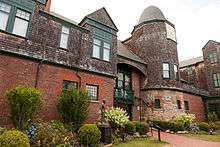Jimmy Van Alen
James Henry Van Alen II (September 19, 1902 – July 3, 1991) was an American tennis official. He is best known for being the founder of the International Tennis Hall of Fame, the largest tennis museum in the world. A poet, musician, publisher, civic leader and raconteur, Jimmy Van Alen achieved his greatest renown in tennis. His greatest legacies are as the inventor of the tiebreak in tennis, and as founder and primary benefactor of the International Tennis Hall of Fame and Museum at the Newport Casino, which he gave to the United States Tennis Association in 1954, saving the national landmark from a proposed car park.
 Statue of Jimmy Van Alen in the International Tennis Hall of Fame courtyard | |
| Full name | James H. Van Alen |
|---|---|
| Country (sports) | |
| Born | 19 September 1902 Newport, Rhode Island, USA |
| Died | 3 July 1991 (aged 88) Newport, Rhode Island, USA |
| Plays | Right-handed (one-handed backhand) |
| Int. Tennis HoF | 1965 (member page) |
| Singles | |
| Grand Slam Singles results | |
| French Open | 2R (1927) |
| Wimbledon | 1R (1922, 1924, 1925) |
| US Open | 2R (1931) |
Biography
Van Alen was born on September 19, 1902, in Newport, Rhode Island, United States, to James Laurens Van Alen (1878–1927) and Margaret Louise Post (1876–1969). His paternal grandparents were James John Van Alen (1848–1923) and Emily Astor (1854–1881) of the Astor family. These and other details are found in his 2010 biography[1]
He graduated in 1924 from Christ's College, Cambridge and won his blue for Lawn Tennis. He was a member of the Hawks' Club in Cambridge where the main lounge is named the 'Jimmy Van Alen Room'. He was an avid tennis player and was a national singles and doubles champion in court tennis.
He helped found the International Tennis Hall of Fame in 1954 at the Newport Casino in Newport, Rhode Island. One of his contributions to the game was the development of the Van Alen Streamlined Scoring System (VASSS) which, among other elements, advocated a sudden-death tie breaker to end prolonged sets and matches. Van Alen actively promoted his system and in 1970 the U.S Open became the first Grand Slam tournament to introduce, on an experimental basis, the tie-break. Initially it was a best-of-nine-points, sudden death tie-break which made it possible to have simultaneous match points for both players. Via a few intermediary steps this would evolve into the current best-of-twelve-point tie-break.[2][3]
He was inducted into the Tennis Hall of Fame in 1965.
He was a great fan of Clement C. Moore's famous poem A Visit from Saint Nicholas which is more commonly known as Twas the Night Before Christmas. He purchased and restored the Clement C. Moore house on Catherine Street in Newport, RI and would make an annual public reading of the poem to children during the Christmas season.
He died after striking his head in a fall at his home on July 3, 1991. He is buried with his wife at the Berkeley Memorial Cemetery at Saint Columba's Chapel in Middletown, Rhode Island.
Legacy
Two days after his death, on July 5, 1991, in a Wimbledon semifinal, Stefan Edberg lost to Michael Stich 6–4, 6–7(5–7), 6–7(5–7), 6–7(2–7). Edberg did not lose serve. Later, after hearing of Van Alen's death, Edberg said: "If he hadn't lived, Michael and I might still be out there playing".
Contributions
- President, Newport Casino 1952
- President/Founder of National Hall of Fame
- Inventor of the first tie breaker
- Inventor of VASSS (Van Alen Streamlined Scoring System)
- National Court Tennis singles and doubles champion.
References
- Dwight, Eleanor. Jimmy Van Alen and Tennis in the 20th Century'. New York: MT Train/Scala Books, 2010
- Grimsley, Will (1971). Tennis: Its History, People and Events. Englewood Cliffs, N.J.: Prentice-Hall. pp. 26–30. ISBN 0139033777.
- Tignor, Steve. "1970: The Tiebreaker Is Introduced". tennis.com. Retrieved July 17, 2015.